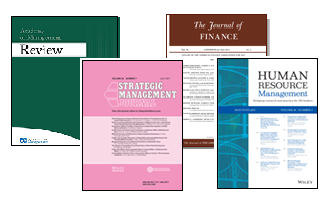So what is a ‘peer reviewed’ journal?
17/06/2015

If you are searching databases of journal articles you are likely to find that one of the ways in which you can limit your search is by restricting items retrieved to Scholarly (Peer Reviewed) journals. But if you do this, which journals are you narrowing your search to and why might you wish to do so?
The aim of peer review is to assess the quality of articles submitted for publication in a scholarly journal. Before an article can be published in a peer reviewed journal it must go through the following process:
- The manuscript is submitted by the author to the editor of the journal
- The editor then sends this to experts in the field who, because they specialise in the same area, are considered to be the author’s “peers”. In some cases the author’s identity is known to the reviewer but sometimes the articles undergo “blind peer review” which means that the author’s identity is not revealed, or even “double blind peer review”, where both the author and reviewers names are concealed.
- The reviewers must carefully ensure the quality of the manuscript. They will check for accuracy and assess the validity of the research methodology and procedures.
- If appropriate, the reviewers will suggest revisions. Once the author has undertaken any revisions the manuscript will be resubmitted and if no further revisions are requested it will be accepted. If they find the article is lacking in scholarly validity or rigour they will reject it.
Because of the rigour of this process, articles that are accepted for publication are deemed to exemplify the best practices in a research field. Peer reviewed journals therefore tend to have a high impact factor and be highly ranked.
Examples of peer reviewed journals include:
- Academy of Management Review; Journal of Marketing; California Management Review; Strategic Management Journal; Human Resource Management; MIS Quarterly; Journal of Finance.
 Many peer reviewed articles in business and management journals will follow a similar format and include:
Many peer reviewed articles in business and management journals will follow a similar format and include:

All will have an abstract and references.
You may be surprised to find that some journals which are highly thought of and frequently seen to be thought leaders are not peer reviewed! Two of the most prestigious of these are Harvard Business Review and McKinsey Quarterly.
If you have any questions about peer reviewed journals or any other aspects of your research, please do not hesitate to contact us.
Feature image from Pixabay. Available at: https://pixabay.com/photos/student-typing-keyboard-text-woman-849824/
Categories & Tags:
Leave a comment on this post:
You might also like…
Preparing for assignments and exams?
Sorry! We know it seems a bit mean to mention the exams in January rather than looking forward to the break before it! However, we know many of you will be thinking about your forthcoming ...
Screening for FTSE 100 companies on Bloomberg
So you’re researching an index and need some data on its constituent companies? Bloomberg’s Equity Screening tool makes light work of this, not just for the FTSE, but for indices, exchanges and sectors worldwide. Type EQS ...
Accelerating my future: How Cranfield put me on the fast track to automotive safety innovation
Hello! I’m Michaela Kaiser, and I’m thrilled to share my journey studying abroad. I’m from Calgary, Canada, and I recently graduated from Cranfield’s MSc Automotive Engineering course. My path to Cranfield ...
From Myanmar to Cranfield: My path to Renewable Energy
As someone who is passionate about sustainability, my career goal is to build a path in the renewable energy sector. My aspirations comes from the benefits of developing sustainable energy sources and ensuring energy ...
From lifelong dream to circular economy leader: Q&A with Himesha Randeni on the Environmental Management for Business MSc
What does it take to turn a lifelong passion for the planet into a fulfilling and impactful career? For Himesha Randeni, the answer was the Environmental Management for Business MSc at ...
Library services over the Christmas period
Kings Norton Library will be open 24/7 throughout the holiday period as a study space. Library staff will work until 6pm on Friday 19 December and will resume their normal working hours from 9am on ...






